Business Valuation Report: An Analysis of Valuing Cash-Rich Companies
VerifiedAdded on 2023/06/12
|6
|1352
|97
Report
AI Summary
This report presents a critique of an article discussing the difficulties in valuing cash-rich companies. It argues that businesses with minimal debt pose valuation challenges compared to those with higher borrowings. The author examines arguments related to conventional valuation formulas and the unique financial structures of tech giants, questioning assumptions about risk-free asset investments and the handling of large cash reserves. Alternative valuation methods, such as comparable analysis and discounted cash flow analysis, are suggested to address these challenges. The report concludes by highlighting the article's failure to convincingly demonstrate the impossibility of valuing cash-rich companies, while acknowledging its objective discussion of relevant arguments. Desklib provides access to this and other solved assignments.

Running head: BUSINESS VALUATION 1
Valuation
Name:
Institution:
Date:
Valuation
Name:
Institution:
Date:
Paraphrase This Document
Need a fresh take? Get an instant paraphrase of this document with our AI Paraphraser
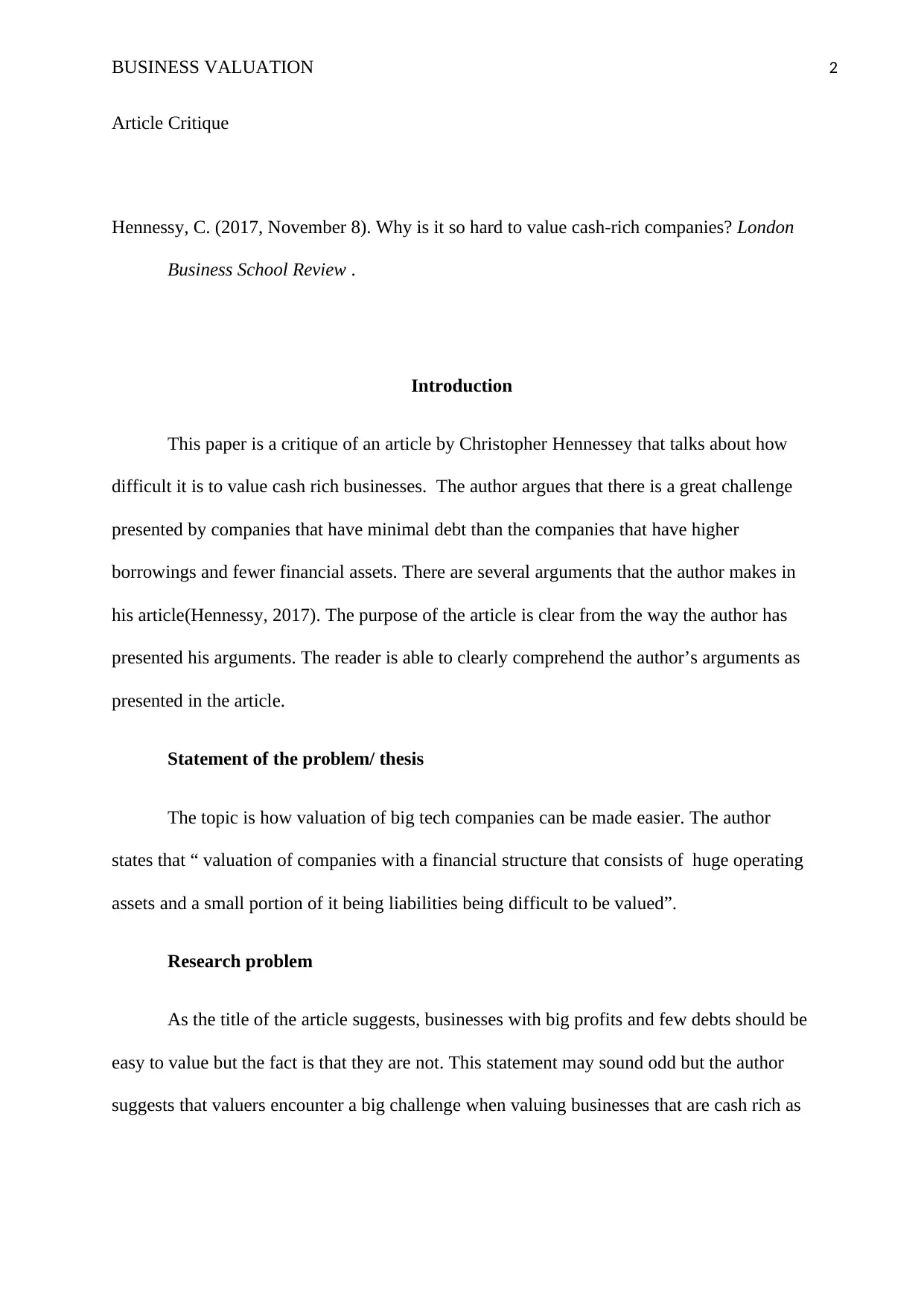
BUSINESS VALUATION 2
Article Critique
Hennessy, C. (2017, November 8). Why is it so hard to value cash-rich companies? London
Business School Review .
Introduction
This paper is a critique of an article by Christopher Hennessey that talks about how
difficult it is to value cash rich businesses. The author argues that there is a great challenge
presented by companies that have minimal debt than the companies that have higher
borrowings and fewer financial assets. There are several arguments that the author makes in
his article(Hennessy, 2017). The purpose of the article is clear from the way the author has
presented his arguments. The reader is able to clearly comprehend the author’s arguments as
presented in the article.
Statement of the problem/ thesis
The topic is how valuation of big tech companies can be made easier. The author
states that “ valuation of companies with a financial structure that consists of huge operating
assets and a small portion of it being liabilities being difficult to be valued”.
Research problem
As the title of the article suggests, businesses with big profits and few debts should be
easy to value but the fact is that they are not. This statement may sound odd but the author
suggests that valuers encounter a big challenge when valuing businesses that are cash rich as
Article Critique
Hennessy, C. (2017, November 8). Why is it so hard to value cash-rich companies? London
Business School Review .
Introduction
This paper is a critique of an article by Christopher Hennessey that talks about how
difficult it is to value cash rich businesses. The author argues that there is a great challenge
presented by companies that have minimal debt than the companies that have higher
borrowings and fewer financial assets. There are several arguments that the author makes in
his article(Hennessy, 2017). The purpose of the article is clear from the way the author has
presented his arguments. The reader is able to clearly comprehend the author’s arguments as
presented in the article.
Statement of the problem/ thesis
The topic is how valuation of big tech companies can be made easier. The author
states that “ valuation of companies with a financial structure that consists of huge operating
assets and a small portion of it being liabilities being difficult to be valued”.
Research problem
As the title of the article suggests, businesses with big profits and few debts should be
easy to value but the fact is that they are not. This statement may sound odd but the author
suggests that valuers encounter a big challenge when valuing businesses that are cash rich as
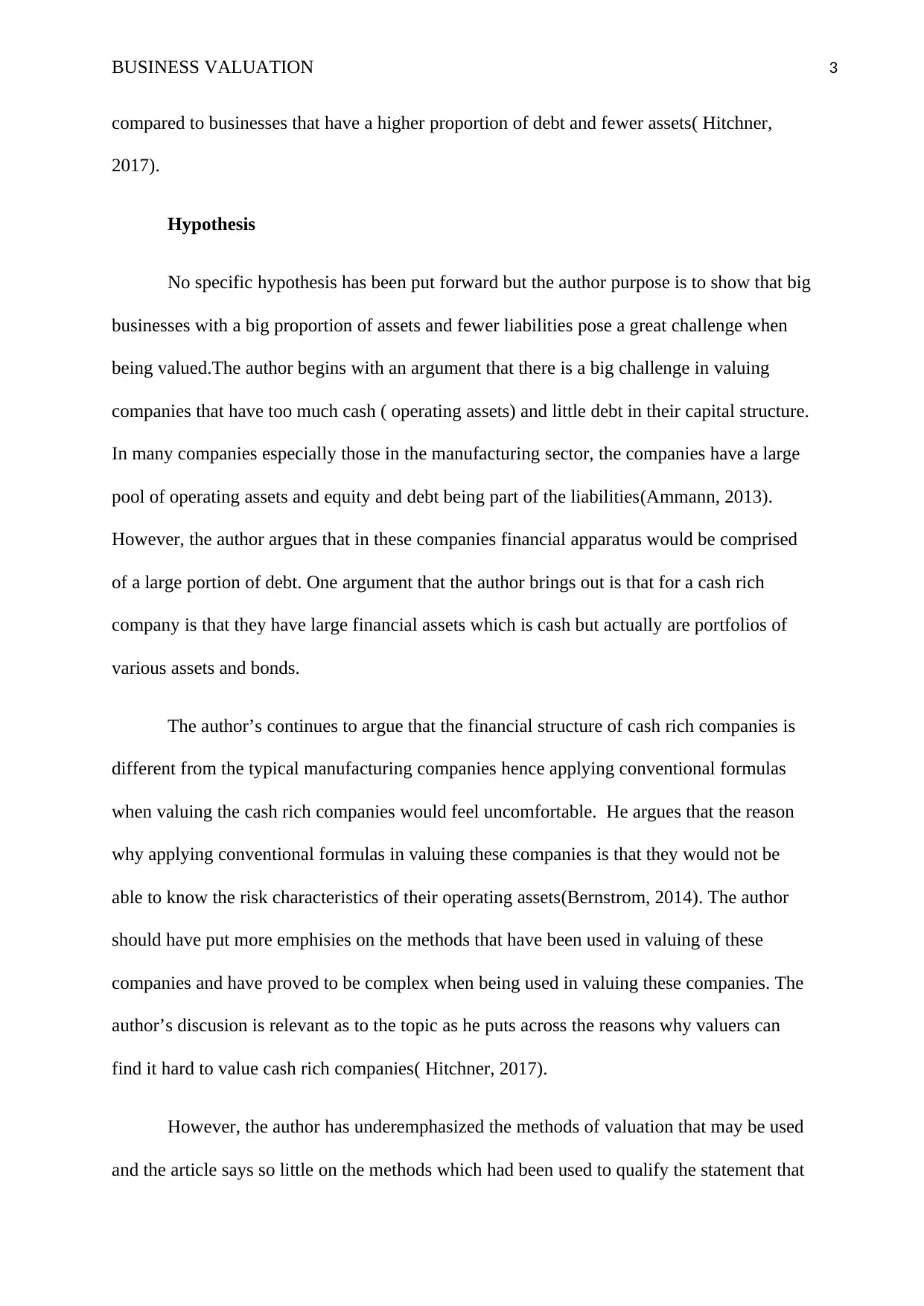
BUSINESS VALUATION 3
compared to businesses that have a higher proportion of debt and fewer assets( Hitchner,
2017).
Hypothesis
No specific hypothesis has been put forward but the author purpose is to show that big
businesses with a big proportion of assets and fewer liabilities pose a great challenge when
being valued.The author begins with an argument that there is a big challenge in valuing
companies that have too much cash ( operating assets) and little debt in their capital structure.
In many companies especially those in the manufacturing sector, the companies have a large
pool of operating assets and equity and debt being part of the liabilities(Ammann, 2013).
However, the author argues that in these companies financial apparatus would be comprised
of a large portion of debt. One argument that the author brings out is that for a cash rich
company is that they have large financial assets which is cash but actually are portfolios of
various assets and bonds.
The author’s continues to argue that the financial structure of cash rich companies is
different from the typical manufacturing companies hence applying conventional formulas
when valuing the cash rich companies would feel uncomfortable. He argues that the reason
why applying conventional formulas in valuing these companies is that they would not be
able to know the risk characteristics of their operating assets(Bernstrom, 2014). The author
should have put more emphisies on the methods that have been used in valuing of these
companies and have proved to be complex when being used in valuing these companies. The
author’s discusion is relevant as to the topic as he puts across the reasons why valuers can
find it hard to value cash rich companies( Hitchner, 2017).
However, the author has underemphasized the methods of valuation that may be used
and the article says so little on the methods which had been used to qualify the statement that
compared to businesses that have a higher proportion of debt and fewer assets( Hitchner,
2017).
Hypothesis
No specific hypothesis has been put forward but the author purpose is to show that big
businesses with a big proportion of assets and fewer liabilities pose a great challenge when
being valued.The author begins with an argument that there is a big challenge in valuing
companies that have too much cash ( operating assets) and little debt in their capital structure.
In many companies especially those in the manufacturing sector, the companies have a large
pool of operating assets and equity and debt being part of the liabilities(Ammann, 2013).
However, the author argues that in these companies financial apparatus would be comprised
of a large portion of debt. One argument that the author brings out is that for a cash rich
company is that they have large financial assets which is cash but actually are portfolios of
various assets and bonds.
The author’s continues to argue that the financial structure of cash rich companies is
different from the typical manufacturing companies hence applying conventional formulas
when valuing the cash rich companies would feel uncomfortable. He argues that the reason
why applying conventional formulas in valuing these companies is that they would not be
able to know the risk characteristics of their operating assets(Bernstrom, 2014). The author
should have put more emphisies on the methods that have been used in valuing of these
companies and have proved to be complex when being used in valuing these companies. The
author’s discusion is relevant as to the topic as he puts across the reasons why valuers can
find it hard to value cash rich companies( Hitchner, 2017).
However, the author has underemphasized the methods of valuation that may be used
and the article says so little on the methods which had been used to qualify the statement that
⊘ This is a preview!⊘
Do you want full access?
Subscribe today to unlock all pages.

Trusted by 1+ million students worldwide
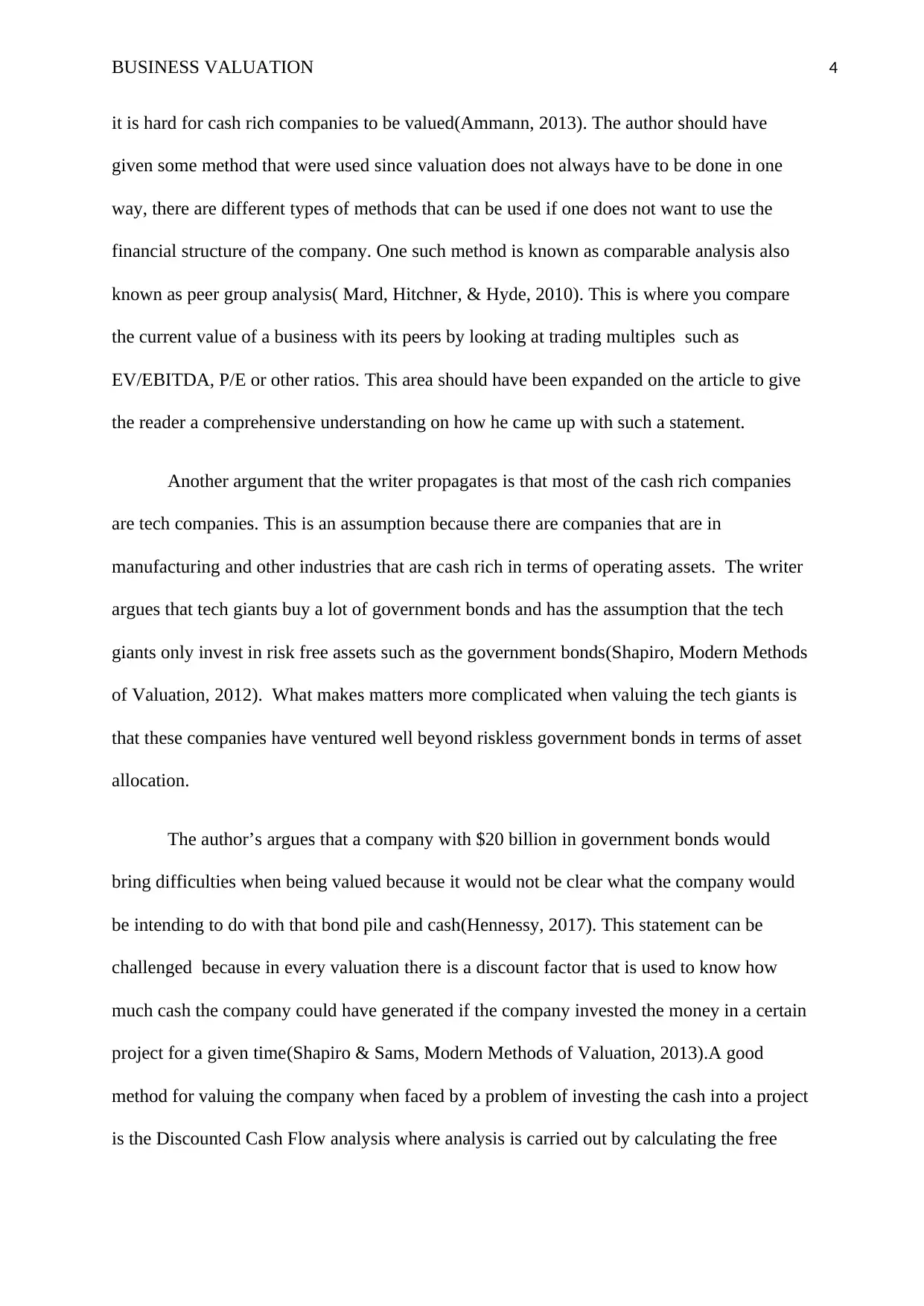
BUSINESS VALUATION 4
it is hard for cash rich companies to be valued(Ammann, 2013). The author should have
given some method that were used since valuation does not always have to be done in one
way, there are different types of methods that can be used if one does not want to use the
financial structure of the company. One such method is known as comparable analysis also
known as peer group analysis( Mard, Hitchner, & Hyde, 2010). This is where you compare
the current value of a business with its peers by looking at trading multiples such as
EV/EBITDA, P/E or other ratios. This area should have been expanded on the article to give
the reader a comprehensive understanding on how he came up with such a statement.
Another argument that the writer propagates is that most of the cash rich companies
are tech companies. This is an assumption because there are companies that are in
manufacturing and other industries that are cash rich in terms of operating assets. The writer
argues that tech giants buy a lot of government bonds and has the assumption that the tech
giants only invest in risk free assets such as the government bonds(Shapiro, Modern Methods
of Valuation, 2012). What makes matters more complicated when valuing the tech giants is
that these companies have ventured well beyond riskless government bonds in terms of asset
allocation.
The author’s argues that a company with $20 billion in government bonds would
bring difficulties when being valued because it would not be clear what the company would
be intending to do with that bond pile and cash(Hennessy, 2017). This statement can be
challenged because in every valuation there is a discount factor that is used to know how
much cash the company could have generated if the company invested the money in a certain
project for a given time(Shapiro & Sams, Modern Methods of Valuation, 2013).A good
method for valuing the company when faced by a problem of investing the cash into a project
is the Discounted Cash Flow analysis where analysis is carried out by calculating the free
it is hard for cash rich companies to be valued(Ammann, 2013). The author should have
given some method that were used since valuation does not always have to be done in one
way, there are different types of methods that can be used if one does not want to use the
financial structure of the company. One such method is known as comparable analysis also
known as peer group analysis( Mard, Hitchner, & Hyde, 2010). This is where you compare
the current value of a business with its peers by looking at trading multiples such as
EV/EBITDA, P/E or other ratios. This area should have been expanded on the article to give
the reader a comprehensive understanding on how he came up with such a statement.
Another argument that the writer propagates is that most of the cash rich companies
are tech companies. This is an assumption because there are companies that are in
manufacturing and other industries that are cash rich in terms of operating assets. The writer
argues that tech giants buy a lot of government bonds and has the assumption that the tech
giants only invest in risk free assets such as the government bonds(Shapiro, Modern Methods
of Valuation, 2012). What makes matters more complicated when valuing the tech giants is
that these companies have ventured well beyond riskless government bonds in terms of asset
allocation.
The author’s argues that a company with $20 billion in government bonds would
bring difficulties when being valued because it would not be clear what the company would
be intending to do with that bond pile and cash(Hennessy, 2017). This statement can be
challenged because in every valuation there is a discount factor that is used to know how
much cash the company could have generated if the company invested the money in a certain
project for a given time(Shapiro & Sams, Modern Methods of Valuation, 2013).A good
method for valuing the company when faced by a problem of investing the cash into a project
is the Discounted Cash Flow analysis where analysis is carried out by calculating the free
Paraphrase This Document
Need a fresh take? Get an instant paraphrase of this document with our AI Paraphraser
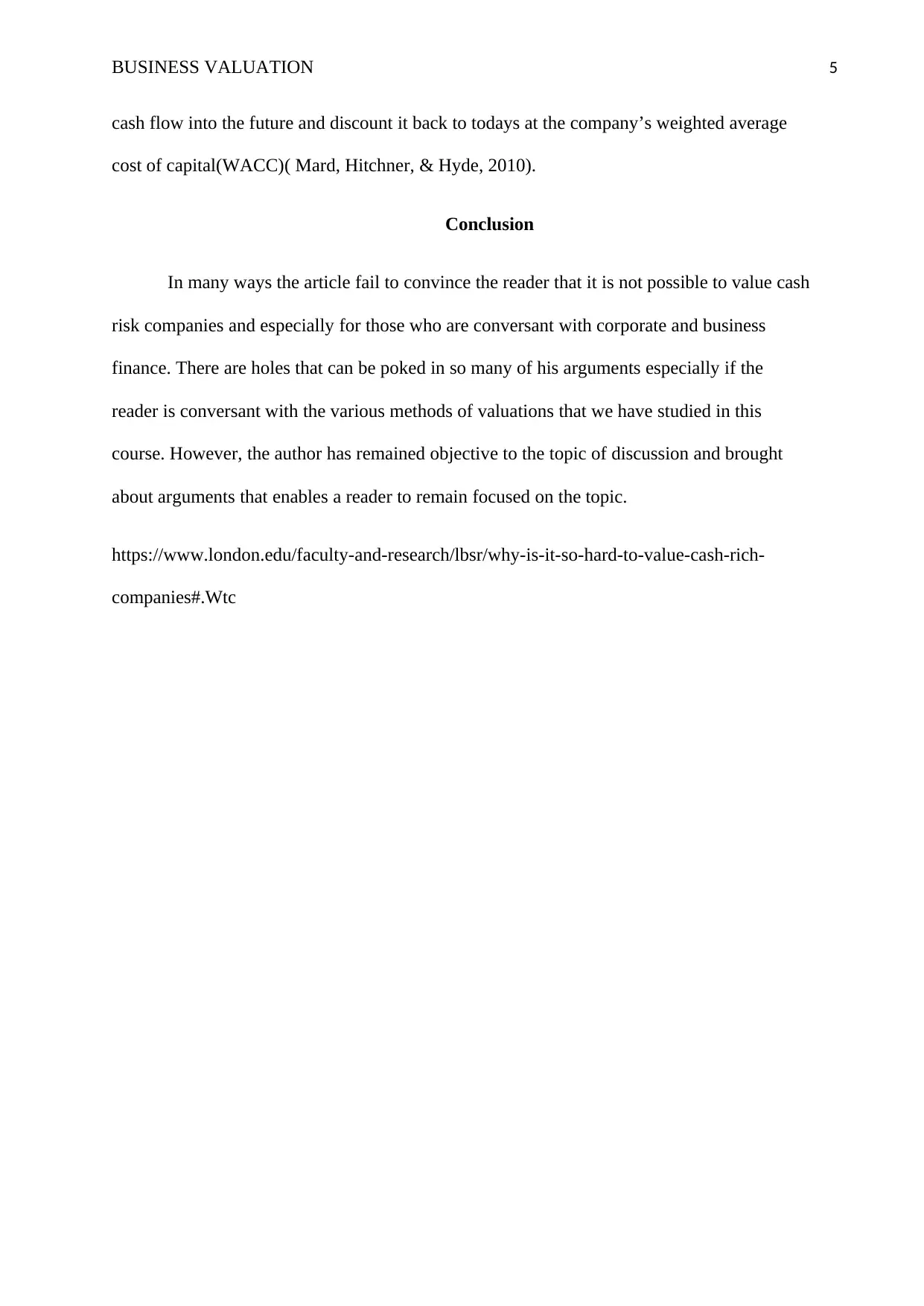
BUSINESS VALUATION 5
cash flow into the future and discount it back to todays at the company’s weighted average
cost of capital(WACC)( Mard, Hitchner, & Hyde, 2010).
Conclusion
In many ways the article fail to convince the reader that it is not possible to value cash
risk companies and especially for those who are conversant with corporate and business
finance. There are holes that can be poked in so many of his arguments especially if the
reader is conversant with the various methods of valuations that we have studied in this
course. However, the author has remained objective to the topic of discussion and brought
about arguments that enables a reader to remain focused on the topic.
https://www.london.edu/faculty-and-research/lbsr/why-is-it-so-hard-to-value-cash-rich-
companies#.Wtc
cash flow into the future and discount it back to todays at the company’s weighted average
cost of capital(WACC)( Mard, Hitchner, & Hyde, 2010).
Conclusion
In many ways the article fail to convince the reader that it is not possible to value cash
risk companies and especially for those who are conversant with corporate and business
finance. There are holes that can be poked in so many of his arguments especially if the
reader is conversant with the various methods of valuations that we have studied in this
course. However, the author has remained objective to the topic of discussion and brought
about arguments that enables a reader to remain focused on the topic.
https://www.london.edu/faculty-and-research/lbsr/why-is-it-so-hard-to-value-cash-rich-
companies#.Wtc
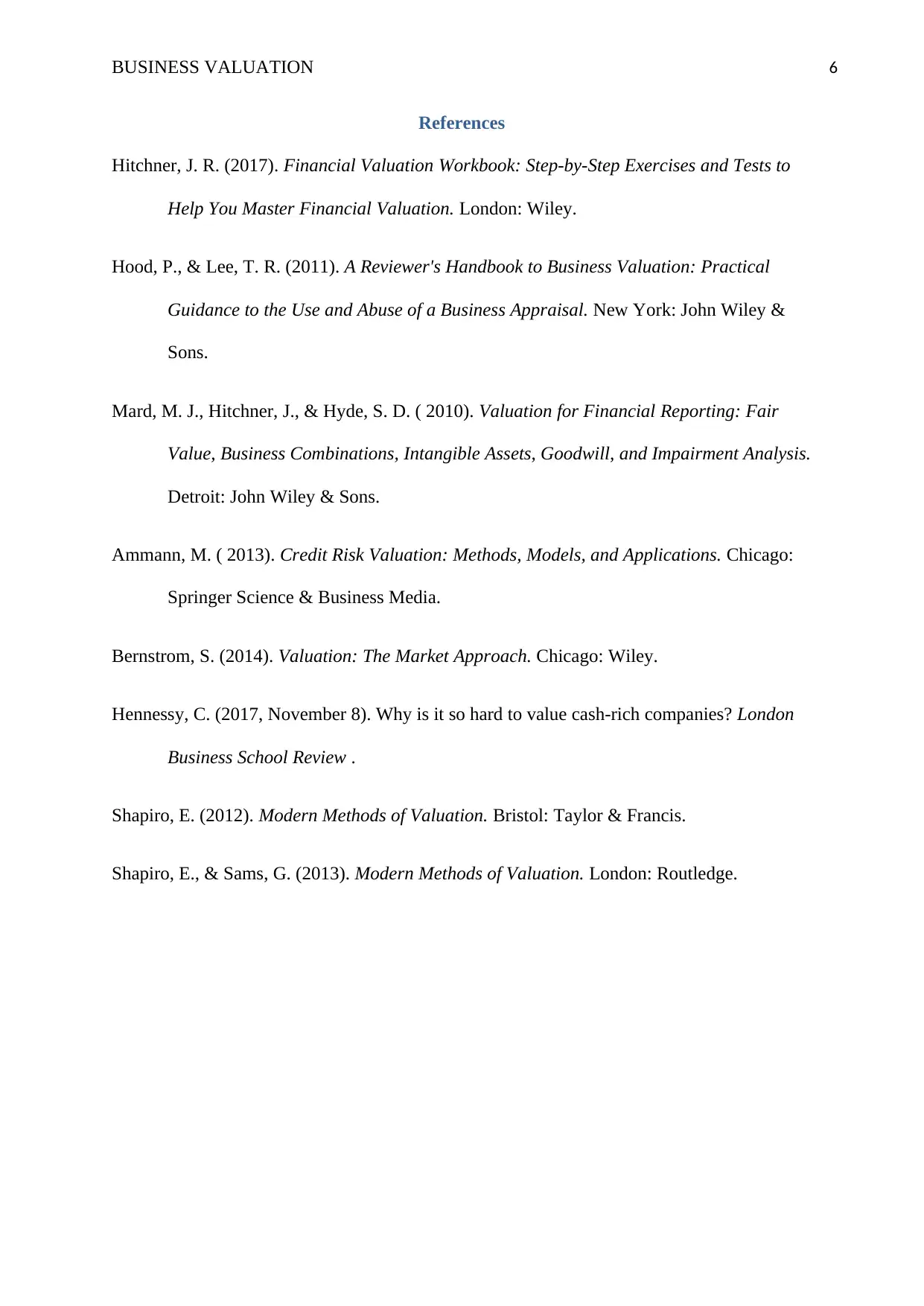
BUSINESS VALUATION 6
References
Hitchner, J. R. (2017). Financial Valuation Workbook: Step-by-Step Exercises and Tests to
Help You Master Financial Valuation. London: Wiley.
Hood, P., & Lee, T. R. (2011). A Reviewer's Handbook to Business Valuation: Practical
Guidance to the Use and Abuse of a Business Appraisal. New York: John Wiley &
Sons.
Mard, M. J., Hitchner, J., & Hyde, S. D. ( 2010). Valuation for Financial Reporting: Fair
Value, Business Combinations, Intangible Assets, Goodwill, and Impairment Analysis.
Detroit: John Wiley & Sons.
Ammann, M. ( 2013). Credit Risk Valuation: Methods, Models, and Applications. Chicago:
Springer Science & Business Media.
Bernstrom, S. (2014). Valuation: The Market Approach. Chicago: Wiley.
Hennessy, C. (2017, November 8). Why is it so hard to value cash-rich companies? London
Business School Review .
Shapiro, E. (2012). Modern Methods of Valuation. Bristol: Taylor & Francis.
Shapiro, E., & Sams, G. (2013). Modern Methods of Valuation. London: Routledge.
References
Hitchner, J. R. (2017). Financial Valuation Workbook: Step-by-Step Exercises and Tests to
Help You Master Financial Valuation. London: Wiley.
Hood, P., & Lee, T. R. (2011). A Reviewer's Handbook to Business Valuation: Practical
Guidance to the Use and Abuse of a Business Appraisal. New York: John Wiley &
Sons.
Mard, M. J., Hitchner, J., & Hyde, S. D. ( 2010). Valuation for Financial Reporting: Fair
Value, Business Combinations, Intangible Assets, Goodwill, and Impairment Analysis.
Detroit: John Wiley & Sons.
Ammann, M. ( 2013). Credit Risk Valuation: Methods, Models, and Applications. Chicago:
Springer Science & Business Media.
Bernstrom, S. (2014). Valuation: The Market Approach. Chicago: Wiley.
Hennessy, C. (2017, November 8). Why is it so hard to value cash-rich companies? London
Business School Review .
Shapiro, E. (2012). Modern Methods of Valuation. Bristol: Taylor & Francis.
Shapiro, E., & Sams, G. (2013). Modern Methods of Valuation. London: Routledge.
⊘ This is a preview!⊘
Do you want full access?
Subscribe today to unlock all pages.

Trusted by 1+ million students worldwide
1 out of 6
Related Documents
Your All-in-One AI-Powered Toolkit for Academic Success.
+13062052269
info@desklib.com
Available 24*7 on WhatsApp / Email
![[object Object]](/_next/static/media/star-bottom.7253800d.svg)
Unlock your academic potential
Copyright © 2020–2025 A2Z Services. All Rights Reserved. Developed and managed by ZUCOL.





